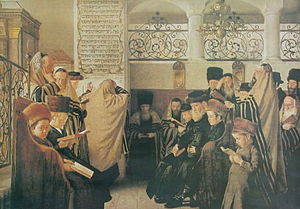Messianic Wars in Midrash – Parashat VaEra
In Exodus 8:2 we read of the second plague of Egypt, frogs: ותעל הצפרדע ותכס את ארץ מצרים. The literal translation of these words is: The frog [singular] came up and covered the land of Egypt. The use of the singular form to describe many objects, animals, or people is quite common on the bible (see for example: Gen. 1:21; 3:1; 12:5; 32:6), but its application here has intrigued the commentators, perhaps because the Torah emphasizes the great number of frogs which will invade Egypt. The word frogs, in the plural, appears ten times, the frogs are described as swarming Egypt, and after they die, they are piled in huge heaps.
It is possible that the singular use in verse 8:2 was meant to poke fun at the Egyptian pantheon. To the Egyptians, the frog was an ancient symbol of fertility, related to the annual flooding of the Nile. They also believed that the queen of heaven, the goddess Nunut, stretched her body over the land of Egypt to protect the land and carry the heavenly bodies. The biblical text draws an image of a frog, instead of the queen of heaven, covering the land, and instead of the flooding of the Nile, the land is flooded by frogs.
Rashi, in his commentary, mentions that the singular is sometimes used to describe the plural in the bible, but prefaces this comment with a Midrashic quote:
צפרדע אחת היתה והיו מכין אותה והיא מתזת נחילים נחילים זהו מדרשו
There was only one frog, and when the Egyptians would beat it with sticks, swarms of frogs would ricochet from it.
The Midrash could have been influenced by the Greek story of the mythological Hydra of Lernae, which had many heads and every time someone would cut off one of them, two more heads would grow out of the stump. The sages of the Midrash borrowed freely from Greek literature and mythology, though they adapted them for their audience. There is, however, another interesting element in this Midrashic interpretation. Rashi quotes only half the Midrash, and here is the full text:
שמות רבה, פרשת וארא, פרשה י
רבי עקיבא אומר, צפרדע אחת היתה והיא השריצה ומלאה את ארץ מצרים. אמר לו רבי אלעזר בן עזריה, עקיבא! מה לך אצל הגדה? כלה מדברותיך ולך אצל נגעים ואהלות! צפרדע אחת היתה ושרקה להן ובאו
R. Akiva says, there was one frog which gave birth to swarms of frogs which covered the land of Egypt. R. Elazar ben Azariah told him: Akiva! Why are you teaching Midrash? Keep quiet and go to the laws of impurity! There was one frog, who whistled to the rest and brought them up from the Nile.
Why was R. Elazar upset with R. Akiva, and why did he suggest that R. Akiva should engage in teaching the laws of impurity?
The answer is in another, seemingly unrelated, Midrashic exchange. This time, the debate between the rabbis was over Daniel 7:9, where Daniel describes a vision he had, in which two thrones are set up for God to sit on.
ילקוט שמעוני, דניאל, רמז תתרסה, על פי חגיגה יד, א
עד די כָּרְסְוָן רְמִיו ועתיק יומין יתיב. ומאי כרסון רמיו? אחת לו ואחת לדוד, דברי ר’ עקיבא. אמר ליה ר’ יוסי הגלילי, עקיבא! עד מתי אתה עושה קדש חול? אלא אחת לדין ואחת לצדקה. תניא אידך, אחד לדין ואחד לצדקה דברי ר’ עקיבא. אמר ליה ר’ אלעזר בן עזריה, עקיבא! מה לך אצל אגדה? כלך מדברותיך ולך אצל נגעים ואהלות. אלא אחד לכסא ואחד לשרפרף, כסא לישב עליו, שרפרף להדום רגליו
Why are there two thrones? R. Akiva said, one for God and one for King David. R. Yose the Galilean tole him: Akiva, until when will you continue to turn the sacred into mundane? Rather say that the two thrones represent judgment and mercy. R. Akiva repeated the comment he heard from R. Yose to R. Elazar ben Azariah, who rebuked him and said: Akiva! Why are you teaching Midrash? Keep quiet and go to the laws of impurity! One of the thrones is a chair and the other is a stool. God sits on the chair and places His feet on the stool.
This discussion is even more baffling than the one about the frogs. There, the explanation suggested by R. Akiva is somewhat fantastic, and we can understand why it is rejected by R. Elazar. Here, R. Akiva repeats an interpretation which is not his, and which sees the two thrones as representing two attributes of God, an approach which later on became a central one in Jewish theology. R. Elazar rejects it without offering any arguments, and proceeds to present an anthropomorphic interpretation. It seems that R. Elazar was determined to prevent R. Akiva from lecturing in the Midrash department of the Mishnaic university. Why is that?
The answer is that R. Akiva was a charismatic leader in both the spiritual and political world, and while the rabbis had tremendous respect for his intellectual abilities, most of them disagreed with his political path. R. Akiva supported Shimon bar Kokhva and his rebellion against the Roman Empire, but most rabbis believed that the rebellion will fail and that it will breed disaster, and unfortunately, they were right. The Roman Empire crushed the rebellion with unprecedented cruelty and decimated the Jewish population of Israel. The Jews, who were starting to recover from the great rebellion and the destruction of the Second Temple sixty years earlier, have lost everything as a result of Bar Kokhva’s rebellion, and the community never recovered again. We can never know what would have happened had R. Akiva not supported the rebellion, but we know that his approach was contested. R. Akiva’s support of the rebellion was not limited to words. He traveled the Jewish world, raised funds, and recruited people, many of whom were converts, to fight against the Romans.
We can now understand R. Yose’s and R. Elazar antagonism. They were afraid of the ability of R. Akiva, with his charisma, to persuade young people to join the war, and were especially concerned when he expounded upon biblical verses, since that gave his words greater authority. When R. Akiva explains that there is one throne for God and one for King David, R. Yose sees it as indicating messianic aspirations, since the Messiah is from the Davidic dynasty, and since R. Akiva declared that Bar Kokhva is the Messiah. When R. Yose tells R. Akiva that his words and actions are turning the sacred into mundane, he refers to the labelling of the rebellion as a Holy War. Later, when R. Akiva presents R. Yose’s words to R. Elazar, the latter does not care much for the content, and offers another, less plausible, explanation. His main goal is to prevent R. Akiva from expounding on the Torah to deliver moral or political messages. He tells R. Akiva to study or teach the most complicated laws, those of impurity, but also sends a subliminal message: you should study the laws of the impurity of the dead, because your actions cause violence and death.
This is also the reason that R. Elazar recoils from R. Akiva’s understanding of the plague of the frogs. He feels that R. Akiva is trying to use it as a justification for his actions in supporting the rebellion. The one frog is the leader, whether R. Akiva or Bar Kokhva, and when he is beaten by the Roman soldiers, more people come forth. The hope of R. Akiva and Bar Kokhva was to keep producing, through propaganda campaigns and the most lenient rules of conversion, an indefatigable army, and R. Elazar was weary of the possible results.
In summary, we have seen that an apparently innocent Midrashic interpretation, cited by Rashi, opens a door to a world of historical debates and political conflicts. We are left with the knowledge that we must research well the sources before jumping to conclusion, and with a question: who was right, in the long term, R. Akiva or R. Elazar?









Parashat Behar – Weekday Torah Reading (Moroccan TeAmim)